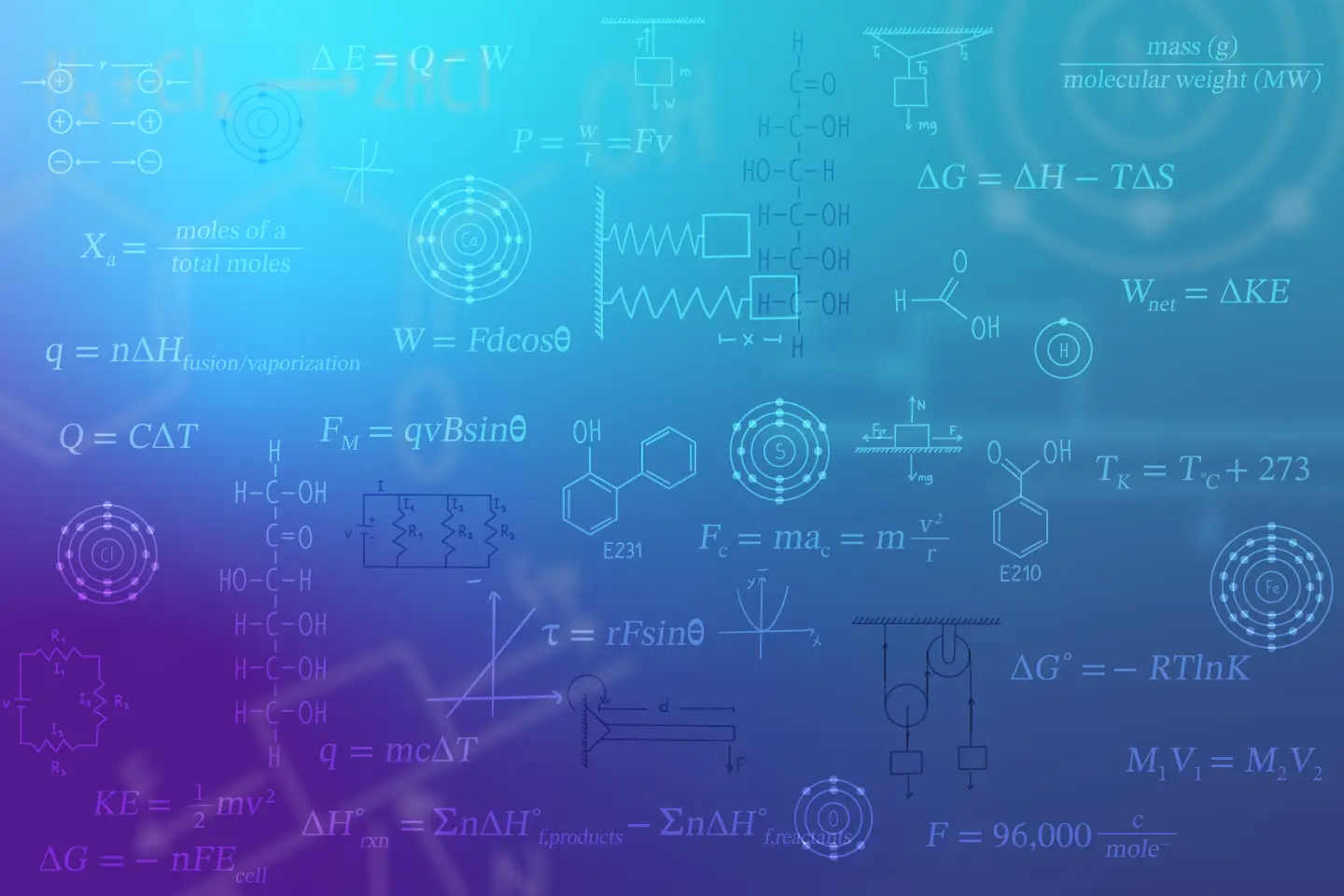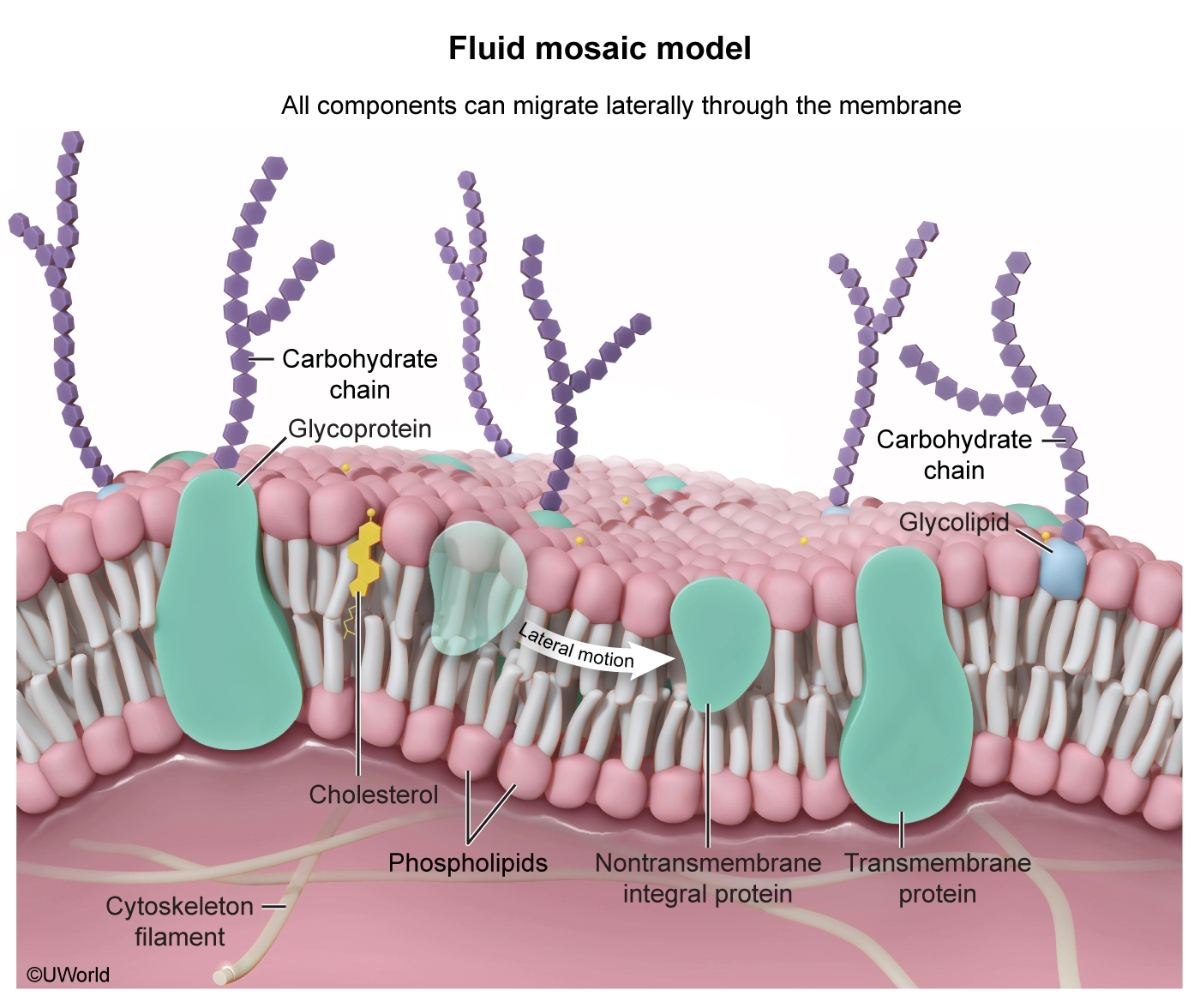MCAT® Equations to Ace Physics and Chemistry

As you prepare for the MCAT, use our equation sheet as a reference when completing practice questions. Write out the equation(s) you use for each problem to strengthen your knowledge.
Do You Get a Formula Sheet on the MCAT?
You do not get a formula sheet on the MCAT. To get a top score, you’ll need to memorize a fair amount of science equations and understand how to apply them quickly. During the exam, you will have access to a blank, laminated notebook and fine point marker to write down your work. The notebook is wet erase so you will not be able to erase your work.
On test day, it may help to write down a handful of common and difficult equations first. You don’t want to spend a lot of time doing this, but it can help ease your nerves and prevent unnecessary errors later. There’s no guarantee a specific equation will appear on the exam, making it crucial that you develop your overall understanding of science concepts.
MCAT Physics Equations
Many students struggle with MCAT physics because of the sheer number of equations, new and unique symbols, and how they relate to one another. They cover a broad range of topics, including mechanics and energy, fluids, electrostatics and circuits, light and sound, and thermodynamics. Here they are in more specific groups:
Work, Energy, and Power
| Work = W = Fd cosθ |
| Kinetic Energy = KE =
1
/
2
mv2
|
| Work Energy Theorem = Wnet = ΔKE |
| Power = P =
W
/
t
= Fv |
| Gravitational Potential Energy = PE = mgh |
| Total Mechanical Energy = E = KE + PE |
Gravity
| Fg = mg |
| g ≃ 10
m
/
s2
|
Projectile Motion
| Horizontal Component: |
| x = vx0t |
| vx = vx0 |
| ax = 0 |
| Vertical Component: |
| y = vy0t
˗
1
/
2
gt2 |
| vy = vy0 - gt |
| ay = - g |
Kinematics
| Constant Acceleration: |
| v = v0 + at |
| d = v0t +
1
/
2
at2 |
Circular Motion
| Centripetal Acceleration =
v2
/
r
|
|
Centripetal Force = Fc = mac = m
v2
/
r
|
Torque
| 𝜏 = rF sinθ |
Thermodynamics
| First Law: ΔE = Q - W |
| Work = W = P · ΔV |
| Heat Capacity: Q = C · ΔT |
| Specific Heat Capacity: Q = mc · ΔT |
Friction
| Fs ≤ μ sFN |
| Fk = μ kFN |
Fluids
| Density = ρ =
mass
/
volume
=
m
/
v
|
|
Specific Gravity = SG =
ρ
/
ρwater
|
| Pressure = P =
F
/
A
|
| Archimedes' Principle: FB = ρfluid · Vdisplaced · g |
| Pascal's Law:
F1
/
A1
=
F2
/
A2
|
| Continuity Equation: A1v1 = A2v2 |
| Flow Rate = Q = Av |
Inclined Plane
| θ = angle of incline |
| Fg parallel = mg sinθ |
| Fg perpendicular = mg cosθ |
Circuits and Electrostatics
| Ohms Law: V = IR |
|
Power = P = IV = I2R =
V2
/
R
|
| Series Resistors = RTotal = R1 + R2 + ... + Rn |
|
Parallel Resistors =
1
/
RTotal
=
1
/
R1
+
1
/
R2
+ ... +
1
/
Rn
|
|
Current = I =
Q
/
t
|
|
Resistance = R = ρ
L
/
A
|
| Coulomb's Law: FE
=
kq1q2
/
r2
|
| Force by an Electric Field = FE = qE |
Capacitors
| Capacitance = C =
Q
/
V
|
| Capacitance = 𝒦ε0
A
/
d
|
| Capacitor Electric Field = E =
V
/
d
|
|
Capacitor Energy = U =
1
/
2
QV
|
|
Series Capacitors:
1
/
CTotal
=
1
/
C1
+
1
/
C2
+ ... +
1
/
Cn
|
| Parallel Capacitors: CTotal = C1 + C2 + ... + Cn |
Magnetism
| Magnetic Force = F = qvB sinθ |
Waves and Oscillations
|
f =
1
/
T
, where f is frequency and T is period
|
| Velocity = v = λf |
| Hooke's Law: Fel = -𝑘𝑥 |
| Harmonics for Open Pipes: f𝑛 =
𝑛v
/
2L
|
| Harmonics for Pipes Closed at One End = f𝑛 =
𝑛oddv
/
4L
|
Lights and Optics
|
E = hf =
hc
/
λ
|
| c = 3 x 108
m
/
s
|
| Index of Refraction = 𝑛 =
c
/
v
|
| Snell's Law: 𝑛1 sinθ1 = 𝑛2 sinθ2 |
|
Lens Equation:
1
/
o
+
1
/
i
=
1
/
f
|
|
Magnification = M = -
i
/
o
|
| Lens Strength = S =
1
/
f
|
Sound
| Velocity = v = λf |
| Intensity = I =
Power
/
Area
|
| Intensity in Decibels = dB = 10 log10
I
/
I0
|
| Doppler Effect: f =
v±vo
/
v∓vs
fs |
MCAT Chemistry Equations
The MCAT equations associated with chemistry are typically found in general chemistry. They can be organized into atomic theory and chemical composition, interactions of chemical substances, thermodynamics, kinetics, and gas laws, and solutions and electrochemistry. Here they are in more specific categories:
Mole, Concentration, and Dilution Relationships
|
Moles =
mass(g)
/
molecular weight (MW)
|
| Avogadro's Number: |
| 1 mole = 6.022 x 1023 particles |
| Mole Fraction = XA =
moles of A
/
total moles
|
|
Molarity = M =
moles
/
L
|
|
Molality = M =
moles
/
kg
|
| Dilution Equation = M1V1 = M2V2 |
Gases
| Standard Temperature and Pressure (STP): |
| T = 0 °C = 273 K; P = 1 atm = 760 torr = 760 mmHg |
| Ideal Gas Law = PV = 𝑛RT |
| Dalton's law of partial Pressures = PTotal = P2 + P1 + ...P𝑛 |
| Graham's Law of Effusion =
v1
/
v2
= √
MW2
/
MW1
|
Atomic Chemistry
| Formal Charge: |
| FC = # valence electrons - # bonds - # lone pair electrons |
Electrochemistry
| F = 96,000 c mole⁻ |
| ΔG = -𝑛FEcell |
Thermodynamics
| TK = T°c + 273 |
| q = mcΔT |
| q = 𝑛ΔHfusion/vaporization |
| ΔH°rxn = ΣnH°f,products − ΣnH°f,reactants |
| Gibbs Free Energy: |
| ΔG = ΔH − TΔS |
| ΔG° = −RTlnK |
Acids and Bases
| pH = −log[H+] |
| pOH = −log[OH−] |
| Kw = [H+][OH−] = 1 × 10−14 at 25 °C |
| pH + pOH = 14 |
|
Ka = [H+] [A−] [HA]
|
| pKa = −logKa |
|
Kb = [OH−] [HB+] [B]
|
| pKb = −logKb |
| Ka × Kb = Kw = 1 × 10−14 |
| Henderson–Hasselbalch Equation: |
|
pH = pKa + log [A−] [HA]
|
Equilibrium
| For the balanced reaction: |
| aA + bB ↔ cC + dD |
|
Equilibrium Constant: Keq = [C]c [D]d [A]a [B]b
|
| Products and reactants at equilibrium. |
|
Reaction Quotient: Q = [C]c [D]d [A]a [B]b
|
Kinetics
| Rate Law = Rate = k[A]a[B]b |
|
Arrhenius Equation: k = Ae −Ea RT
|
Why Use Our MCAT Equation Sheet?
You may be wondering if it makes sense to practice with a formula sheet when you cannot use one on the MCAT itself. This is a valid concern and should be taken into account when preparing for the exam. We recommend pairing our equation sheet with our MCAT QBank early on to get familiar with the formulas through repetition, then weening yourself off as you progress. We organized the formulas to save you valuable time, make it easier to remember how they’re related, and put you in a better position to understand important scientific concepts.
Frequently Asked Questions (FAQs)
Do you have to memorize equations for the MCAT?
Yes. You will not have access to a formula sheet during the exam. This means you will need to spend time memorizing physics and chemistry equations, how they’re related, and when to apply them.
What are some tips to study, memorize, and apply physics and chemistry concepts and equations?
Repetition will help you understand science concepts and apply formulas. We suggest referencing our equation sheet as you complete our MCAT QBank to build your knowledge and confidence.
Will I be provided with a calculator on the MCAT?
No. You are not allowed to use a calculator on the MCAT. However, this means that MCAT math is relatively straightforward and does not require difficult calculations.
Are kinematic equations given on the MCAT?
No. Like other physics equations, you will need to memorize the key kinematic equations. To memorize them:
- Learn the symbols in the equations
- Attain a general understanding of how position, velocity, and acceleration are related (think derivatives and integrals)
- Brush up on your algebra
- Get comfortable applying the formulas through repetition
Read More About the MCAT
Discover our proven MCAT prep course, featuring comprehensive and effective content review, 3,000+ practice questions, and self-study tools.
Practice free MCAT Physics questions and learn common equations through our answer explanations. We'll outline what topics to review for exam day.
Get General Chemistry MCAT help with our free practice questions, answer explanations, and topics overview. Know exactly what to expect on the exam.
Practice Organic Chemistry MCAT questions for free and read our detailed answer explanations. Learn what reactions to know and topics to review.










